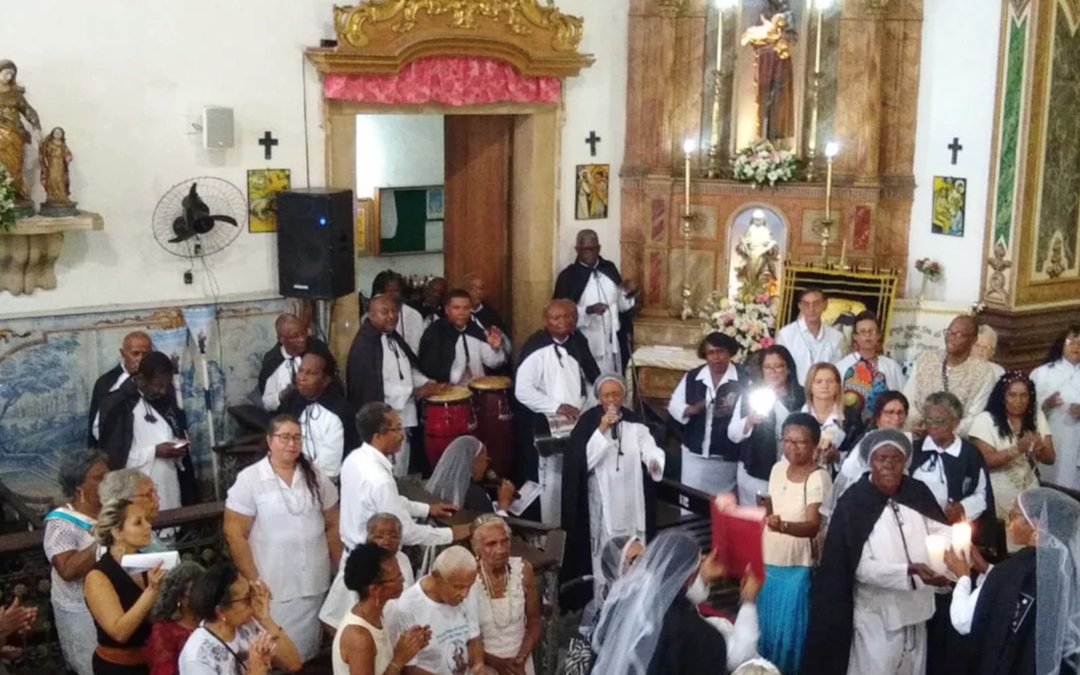
In Brazil, historic black lay Catholic ‘brotherhoods’ fight to survive
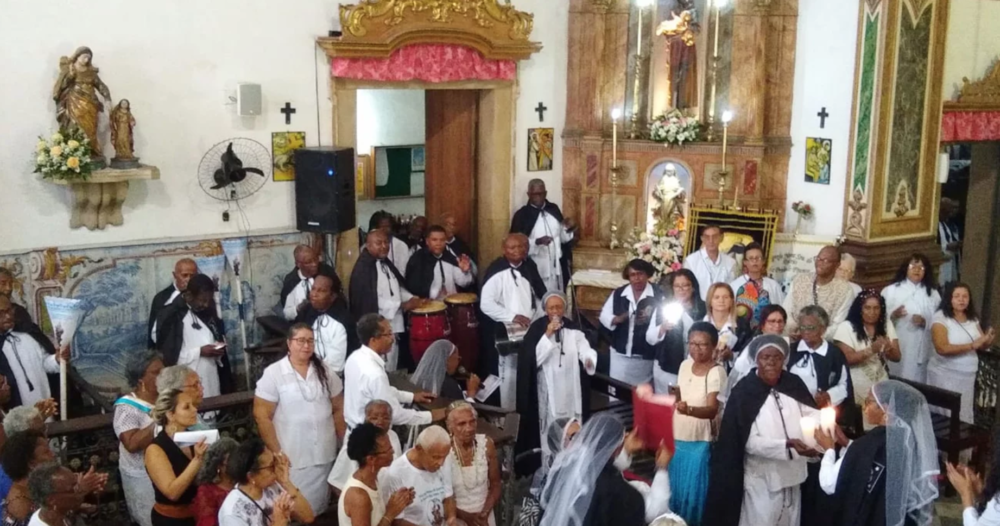
Members of black brotherhoods participate in a service at the Church of Our Lady of the Rosary of the Black Men in Salvador, Brazil. Courtesy photo by William Justo


Members of black brotherhoods participate in a service at the Church of Our Lady of the Rosary of the Black Men in Salvador, Brazil. Courtesy photo by William Justo
At the end of October, members of Brazil’s Catholic black lay associations gathered in the northern port city of Salvador to discuss their centuries-long history and the challenges facing the new network they have formed — an association of associations — in a country where the Catholic Church itself is questioning its future.
Created by slaves and emancipated black men and women in colonial times, when they were not allowed to attend the same churches as their white masters, the black lay associations were once refuges of solidarity and resistance against slavery. Most made efforts to buy freedom for their enslaved members. “Our brotherhood functioned as an important center in the abolitionist struggle,” said Antônio Nicanor, a member of the Brotherhood of the Black Men in Salvador.
But the existence of the black Catholic groups is threatened by the same societal forces that are draining all established religions of members and energy, chiefly the loss of young people. “The average age in our brotherhood is 55,” Nicanor told Religion News Service. “In most of the organizations all over Brazil, there’s no effective renewal.
“Since 2017 we’ve been working to reunite all brotherhoods and communities in Brazil, in an effort to grow stronger,” said Nicanor, referring to the network that is meant to bolster brotherhoods like his. “Our organizations are aging, and we have to fight against their end.”
Some of the decline has to do with problems particular to Brazil’s complex religious landscape. The lay associations have long been concerned with the conservation of African culture in the church, and many members are loyal both to Catholicism and to Afro-Brazilian religions such as Candomblé and Umbanda. These allegiances have caused some Catholic clergy to regard them with suspicion.
“We still suffer with the prejudice of some people in the Church,” said Analia Santana, a member of Nicanor’s Brotherhood of the Black Men and an academic researcher specializing in its history.
“Many priests say they don’t know anything about the black brotherhoods. Seminaries don’t talk about us. What happens if a priest like this is suddenly appointed as our chaplain?” asked Vanilda Silvério, vice-director of the Brotherhood Our Lady of the Rosary of the Black Men, in São Paulo.
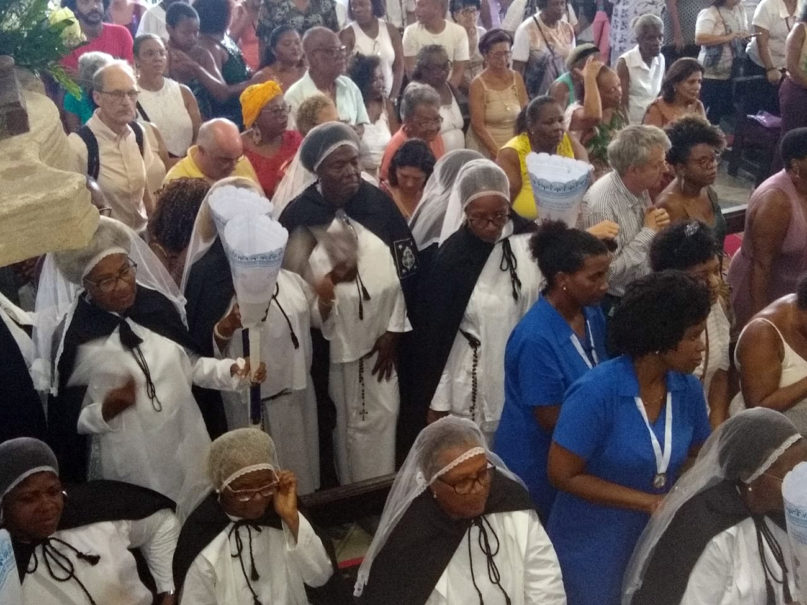
Members of black brotherhoods, which include both men and women, attend a service at the Church of Our Lady of the Rosary of the Black Men in Salvador, Brazil. Courtesy photo by William Justo
(In Portuguese, the term for these communities, “irmandade,” encompasses both men and women, though it is often rendered as “brotherhood” in English, and many specify black men in their titles. Even so, women such as Silvério have only served in leadership roles since the early 2000s.)
Her association has existed in São Paulo since 1711 and counted more than 400 members a few decades ago. Now there are 62 brothers and sisters. “My grandfather joined the brotherhood in the 1920s. Now one of my daughters is also a member,” said Silvério.
Her younger daughter, however, resists the idea of taking part in the group. “I’m 57. I’m worried about the future. I don’t see many young people joining the brotherhood. They don’t have time to contribute — they have to study and work.”
Like many shrinking institutions, Brazil’s lay Catholic associations both benefit from an infrastructure built up during their high times and pay dearly to maintain it. Most of the black fraternities own their churches, cemeteries and other historical buildings and are responsible for their conservation.
They also manage investment funds set aside for these properties’ preservation, for association activities and to pay a few employees, but the members generally lack the financial expertise to do so, according to the Rev. Lázaro Muniz, who was chaplain of the Brotherhood of the Black Men for seven years until early 2019.
During his tenure, Muniz created an archdiocesan commission in Salvador in order to keep up with the brotherhoods’ activities. “They’re independent entities, but we struggled to help them reform their bylaws and make several changes for their own good. Several fraternities had to close due to management problems. Our struggle is to preserve them,” he explained.
He was also one of the proponents of the national network of black Catholic lay associations founded three years ago.
“We hope very much this network will strengthen the brotherhoods. The meetings were very successful, and many of them are already in the process of reorganization,” he said. He added that they are forging bonds with the Afro-Brazilian pastoral commissions in their dioceses that deal with black churchgoers.
Over 500 years, the lay associations have weathered changes in the Church and the larger culture. Nicanor’s Brotherhood of the Black Men, probably the oldest black brotherhood still active in Brazil, shows up in official records in 1685, but there’s evidence it was created in 1604, according to Santana. Their staying power gives current members hope.
“Our brotherhood was always able to dialogue with the changing times and to renew itself. Many other entities had to close their doors throughout the centuries,” Santana explained.
They also have the advantage of being deeply rooted in the lives of rural communities. Though many brotherhoods originated in Salvador, Brazil’s first capital city and still its premier archdiocese, they soon spread across the country. They have long organized annual festivities in honor of their saints of devotion — black saints like Saint Benedict the Moor, Saint Elesbaan, Saint Ephigenia of Ethiopia and Saint Anthony of Carthage, who incorporated elements of the residents’ original African cultures.
These highly ritualized festivities, known as congadas, included the coronation of a king and a queen of the brotherhood. Although many of the urban fraternities don’t organize congadas anymore, they still can be seen in the countryside.
It is this kind of local religious culture that got favorable attention at the recent Synod for the Pan-Amazon Region, where Pope Francis urged bishops to reflect on “enculturation,” as the Church calls adaptation of Christianity to local contexts. Muniz believes this kind of thinking may be helpful in renovation of the Brazilian brotherhoods.
“This moment invites the fraternities to search for news ways, assuming a path of evangelization and offering possibilities for the youth to assume their traditions.”
For Nicanor, the black lay associations still have a contribution to make for a church that, guided by Francis, is looking for more lay involvement. “The church needs to feel that it’s the lay people who make Catholicism and not the clergy,” he said.
At the end of October, members of Brazil’s Catholic black lay associations gathered in the northern port city of Salvador to discuss their centuries-long history and the challenges facing the new network they have formed — an association of associations — in a country where the Catholic Church itself is questioning its future.
Created by slaves and emancipated black men and women in colonial times, when they were not allowed to attend the same churches as their white masters, the black lay associations were once refuges of solidarity and resistance against slavery. Most made efforts to buy freedom for their enslaved members. “Our brotherhood functioned as an important center in the abolitionist struggle,” said Antônio Nicanor, a member of the Brotherhood of the Black Men in Salvador.
But the existence of the black Catholic groups is threatened by the same societal forces that are draining all established religions of members and energy, chiefly the loss of young people. “The average age in our brotherhood is 55,” Nicanor told Religion News Service. “In most of the organizations all over Brazil, there’s no effective renewal.
“Since 2017 we’ve been working to reunite all brotherhoods and communities in Brazil, in an effort to grow stronger,” said Nicanor, referring to the network that is meant to bolster brotherhoods like his. “Our organizations are aging, and we have to fight against their end.”
Some of the decline has to do with problems particular to Brazil’s complex religious landscape. The lay associations have long been concerned with the conservation of African culture in the church, and many members are loyal both to Catholicism and to Afro-Brazilian religions such as Candomblé and Umbanda. These allegiances have caused some Catholic clergy to regard them with suspicion.
“We still suffer with the prejudice of some people in the Church,” said Analia Santana, a member of Nicanor’s Brotherhood of the Black Men and an academic researcher specializing in its history.
“Many priests say they don’t know anything about the black brotherhoods. Seminaries don’t talk about us. What happens if a priest like this is suddenly appointed as our chaplain?” asked Vanilda Silvério, vice-director of the Brotherhood Our Lady of the Rosary of the Black Men, in São Paulo.

Members of black brotherhoods, which include both men and women, attend a service at the Church of Our Lady of the Rosary of the Black Men in Salvador, Brazil. Courtesy photo by William Justo
(In Portuguese, the term for these communities, “irmandade,” encompasses both men and women, though it is often rendered as “brotherhood” in English, and many specify black men in their titles. Even so, women such as Silvério have only served in leadership roles since the early 2000s.)
Her association has existed in São Paulo since 1711 and counted more than 400 members a few decades ago. Now there are 62 brothers and sisters. “My grandfather joined the brotherhood in the 1920s. Now one of my daughters is also a member,” said Silvério.
Her younger daughter, however, resists the idea of taking part in the group. “I’m 57. I’m worried about the future. I don’t see many young people joining the brotherhood. They don’t have time to contribute — they have to study and work.”
Like many shrinking institutions, Brazil’s lay Catholic associations both benefit from an infrastructure built up during their high times and pay dearly to maintain it. Most of the black fraternities own their churches, cemeteries and other historical buildings and are responsible for their conservation.
They also manage investment funds set aside for these properties’ preservation, for association activities and to pay a few employees, but the members generally lack the financial expertise to do so, according to the Rev. Lázaro Muniz, who was chaplain of the Brotherhood of the Black Men for seven years until early 2019.
During his tenure, Muniz created an archdiocesan commission in Salvador in order to keep up with the brotherhoods’ activities. “They’re independent entities, but we struggled to help them reform their bylaws and make several changes for their own good. Several fraternities had to close due to management problems. Our struggle is to preserve them,” he explained.
He was also one of the proponents of the national network of black Catholic lay associations founded three years ago.
“We hope very much this network will strengthen the brotherhoods. The meetings were very successful, and many of them are already in the process of reorganization,” he said. He added that they are forging bonds with the Afro-Brazilian pastoral commissions in their dioceses that deal with black churchgoers.
Over 500 years, the lay associations have weathered changes in the Church and the larger culture. Nicanor’s Brotherhood of the Black Men, probably the oldest black brotherhood still active in Brazil, shows up in official records in 1685, but there’s evidence it was created in 1604, according to Santana. Their staying power gives current members hope.
“Our brotherhood was always able to dialogue with the changing times and to renew itself. Many other entities had to close their doors throughout the centuries,” Santana explained.
They also have the advantage of being deeply rooted in the lives of rural communities. Though many brotherhoods originated in Salvador, Brazil’s first capital city and still its premier archdiocese, they soon spread across the country. They have long organized annual festivities in honor of their saints of devotion — black saints like Saint Benedict the Moor, Saint Elesbaan, Saint Ephigenia of Ethiopia and Saint Anthony of Carthage, who incorporated elements of the residents’ original African cultures.
These highly ritualized festivities, known as congadas, included the coronation of a king and a queen of the brotherhood. Although many of the urban fraternities don’t organize congadas anymore, they still can be seen in the countryside.
It is this kind of local religious culture that got favorable attention at the recent Synod for the Pan-Amazon Region, where Pope Francis urged bishops to reflect on “enculturation,” as the Church calls adaptation of Christianity to local contexts. Muniz believes this kind of thinking may be helpful in renovation of the Brazilian brotherhoods.
“This moment invites the fraternities to search for news ways, assuming a path of evangelization and offering possibilities for the youth to assume their traditions.”
For Nicanor, the black lay associations still have a contribution to make for a church that, guided by Francis, is looking for more lay involvement. “The church needs to feel that it’s the lay people who make Catholicism and not the clergy,” he said.


Members of black brotherhoods participate in a service at the Church of Our Lady of the Rosary of the Black Men in Salvador, Brazil. Courtesy photo by William Justo
At the end of October, members of Brazil’s Catholic black lay associations gathered in the northern port city of Salvador to discuss their centuries-long history and the challenges facing the new network they have formed — an association of associations — in a country where the Catholic Church itself is questioning its future.
Created by slaves and emancipated black men and women in colonial times, when they were not allowed to attend the same churches as their white masters, the black lay associations were once refuges of solidarity and resistance against slavery. Most made efforts to buy freedom for their enslaved members. “Our brotherhood functioned as an important center in the abolitionist struggle,” said Antônio Nicanor, a member of the Brotherhood of the Black Men in Salvador.
But the existence of the black Catholic groups is threatened by the same societal forces that are draining all established religions of members and energy, chiefly the loss of young people. “The average age in our brotherhood is 55,” Nicanor told Religion News Service. “In most of the organizations all over Brazil, there’s no effective renewal.
“Since 2017 we’ve been working to reunite all brotherhoods and communities in Brazil, in an effort to grow stronger,” said Nicanor, referring to the network that is meant to bolster brotherhoods like his. “Our organizations are aging, and we have to fight against their end.”
Some of the decline has to do with problems particular to Brazil’s complex religious landscape. The lay associations have long been concerned with the conservation of African culture in the church, and many members are loyal both to Catholicism and to Afro-Brazilian religions such as Candomblé and Umbanda. These allegiances have caused some Catholic clergy to regard them with suspicion.
“We still suffer with the prejudice of some people in the Church,” said Analia Santana, a member of Nicanor’s Brotherhood of the Black Men and an academic researcher specializing in its history.
“Many priests say they don’t know anything about the black brotherhoods. Seminaries don’t talk about us. What happens if a priest like this is suddenly appointed as our chaplain?” asked Vanilda Silvério, vice-director of the Brotherhood Our Lady of the Rosary of the Black Men, in São Paulo.

Members of black brotherhoods, which include both men and women, attend a service at the Church of Our Lady of the Rosary of the Black Men in Salvador, Brazil. Courtesy photo by William Justo
(In Portuguese, the term for these communities, “irmandade,” encompasses both men and women, though it is often rendered as “brotherhood” in English, and many specify black men in their titles. Even so, women such as Silvério have only served in leadership roles since the early 2000s.)
Her association has existed in São Paulo since 1711 and counted more than 400 members a few decades ago. Now there are 62 brothers and sisters. “My grandfather joined the brotherhood in the 1920s. Now one of my daughters is also a member,” said Silvério.
Her younger daughter, however, resists the idea of taking part in the group. “I’m 57. I’m worried about the future. I don’t see many young people joining the brotherhood. They don’t have time to contribute — they have to study and work.”
Like many shrinking institutions, Brazil’s lay Catholic associations both benefit from an infrastructure built up during their high times and pay dearly to maintain it. Most of the black fraternities own their churches, cemeteries and other historical buildings and are responsible for their conservation.
They also manage investment funds set aside for these properties’ preservation, for association activities and to pay a few employees, but the members generally lack the financial expertise to do so, according to the Rev. Lázaro Muniz, who was chaplain of the Brotherhood of the Black Men for seven years until early 2019.
During his tenure, Muniz created an archdiocesan commission in Salvador in order to keep up with the brotherhoods’ activities. “They’re independent entities, but we struggled to help them reform their bylaws and make several changes for their own good. Several fraternities had to close due to management problems. Our struggle is to preserve them,” he explained.
He was also one of the proponents of the national network of black Catholic lay associations founded three years ago.
“We hope very much this network will strengthen the brotherhoods. The meetings were very successful, and many of them are already in the process of reorganization,” he said. He added that they are forging bonds with the Afro-Brazilian pastoral commissions in their dioceses that deal with black churchgoers.
Over 500 years, the lay associations have weathered changes in the Church and the larger culture. Nicanor’s Brotherhood of the Black Men, probably the oldest black brotherhood still active in Brazil, shows up in official records in 1685, but there’s evidence it was created in 1604, according to Santana. Their staying power gives current members hope.
“Our brotherhood was always able to dialogue with the changing times and to renew itself. Many other entities had to close their doors throughout the centuries,” Santana explained.
They also have the advantage of being deeply rooted in the lives of rural communities. Though many brotherhoods originated in Salvador, Brazil’s first capital city and still its premier archdiocese, they soon spread across the country. They have long organized annual festivities in honor of their saints of devotion — black saints like Saint Benedict the Moor, Saint Elesbaan, Saint Ephigenia of Ethiopia and Saint Anthony of Carthage, who incorporated elements of the residents’ original African cultures.
These highly ritualized festivities, known as congadas, included the coronation of a king and a queen of the brotherhood. Although many of the urban fraternities don’t organize congadas anymore, they still can be seen in the countryside.
It is this kind of local religious culture that got favorable attention at the recent Synod for the Pan-Amazon Region, where Pope Francis urged bishops to reflect on “enculturation,” as the Church calls adaptation of Christianity to local contexts. Muniz believes this kind of thinking may be helpful in renovation of the Brazilian brotherhoods.
“This moment invites the fraternities to search for news ways, assuming a path of evangelization and offering possibilities for the youth to assume their traditions.”
For Nicanor, the black lay associations still have a contribution to make for a church that, guided by Francis, is looking for more lay involvement. “The church needs to feel that it’s the lay people who make Catholicism and not the clergy,” he said.
At the end of October, members of Brazil’s Catholic black lay associations gathered in the northern port city of Salvador to discuss their centuries-long history and the challenges facing the new network they have formed — an association of associations — in a country where the Catholic Church itself is questioning its future.
Created by slaves and emancipated black men and women in colonial times, when they were not allowed to attend the same churches as their white masters, the black lay associations were once refuges of solidarity and resistance against slavery. Most made efforts to buy freedom for their enslaved members. “Our brotherhood functioned as an important center in the abolitionist struggle,” said Antônio Nicanor, a member of the Brotherhood of the Black Men in Salvador.
But the existence of the black Catholic groups is threatened by the same societal forces that are draining all established religions of members and energy, chiefly the loss of young people. “The average age in our brotherhood is 55,” Nicanor told Religion News Service. “In most of the organizations all over Brazil, there’s no effective renewal.
“Since 2017 we’ve been working to reunite all brotherhoods and communities in Brazil, in an effort to grow stronger,” said Nicanor, referring to the network that is meant to bolster brotherhoods like his. “Our organizations are aging, and we have to fight against their end.”
Some of the decline has to do with problems particular to Brazil’s complex religious landscape. The lay associations have long been concerned with the conservation of African culture in the church, and many members are loyal both to Catholicism and to Afro-Brazilian religions such as Candomblé and Umbanda. These allegiances have caused some Catholic clergy to regard them with suspicion.
“We still suffer with the prejudice of some people in the Church,” said Analia Santana, a member of Nicanor’s Brotherhood of the Black Men and an academic researcher specializing in its history.
“Many priests say they don’t know anything about the black brotherhoods. Seminaries don’t talk about us. What happens if a priest like this is suddenly appointed as our chaplain?” asked Vanilda Silvério, vice-director of the Brotherhood Our Lady of the Rosary of the Black Men, in São Paulo.

Members of black brotherhoods, which include both men and women, attend a service at the Church of Our Lady of the Rosary of the Black Men in Salvador, Brazil. Courtesy photo by William Justo
(In Portuguese, the term for these communities, “irmandade,” encompasses both men and women, though it is often rendered as “brotherhood” in English, and many specify black men in their titles. Even so, women such as Silvério have only served in leadership roles since the early 2000s.)
Her association has existed in São Paulo since 1711 and counted more than 400 members a few decades ago. Now there are 62 brothers and sisters. “My grandfather joined the brotherhood in the 1920s. Now one of my daughters is also a member,” said Silvério.
Her younger daughter, however, resists the idea of taking part in the group. “I’m 57. I’m worried about the future. I don’t see many young people joining the brotherhood. They don’t have time to contribute — they have to study and work.”
Like many shrinking institutions, Brazil’s lay Catholic associations both benefit from an infrastructure built up during their high times and pay dearly to maintain it. Most of the black fraternities own their churches, cemeteries and other historical buildings and are responsible for their conservation.
They also manage investment funds set aside for these properties’ preservation, for association activities and to pay a few employees, but the members generally lack the financial expertise to do so, according to the Rev. Lázaro Muniz, who was chaplain of the Brotherhood of the Black Men for seven years until early 2019.
During his tenure, Muniz created an archdiocesan commission in Salvador in order to keep up with the brotherhoods’ activities. “They’re independent entities, but we struggled to help them reform their bylaws and make several changes for their own good. Several fraternities had to close due to management problems. Our struggle is to preserve them,” he explained.
He was also one of the proponents of the national network of black Catholic lay associations founded three years ago.
“We hope very much this network will strengthen the brotherhoods. The meetings were very successful, and many of them are already in the process of reorganization,” he said. He added that they are forging bonds with the Afro-Brazilian pastoral commissions in their dioceses that deal with black churchgoers.
Over 500 years, the lay associations have weathered changes in the Church and the larger culture. Nicanor’s Brotherhood of the Black Men, probably the oldest black brotherhood still active in Brazil, shows up in official records in 1685, but there’s evidence it was created in 1604, according to Santana. Their staying power gives current members hope.
“Our brotherhood was always able to dialogue with the changing times and to renew itself. Many other entities had to close their doors throughout the centuries,” Santana explained.
They also have the advantage of being deeply rooted in the lives of rural communities. Though many brotherhoods originated in Salvador, Brazil’s first capital city and still its premier archdiocese, they soon spread across the country. They have long organized annual festivities in honor of their saints of devotion — black saints like Saint Benedict the Moor, Saint Elesbaan, Saint Ephigenia of Ethiopia and Saint Anthony of Carthage, who incorporated elements of the residents’ original African cultures.
These highly ritualized festivities, known as congadas, included the coronation of a king and a queen of the brotherhood. Although many of the urban fraternities don’t organize congadas anymore, they still can be seen in the countryside.
It is this kind of local religious culture that got favorable attention at the recent Synod for the Pan-Amazon Region, where Pope Francis urged bishops to reflect on “enculturation,” as the Church calls adaptation of Christianity to local contexts. Muniz believes this kind of thinking may be helpful in renovation of the Brazilian brotherhoods.
“This moment invites the fraternities to search for news ways, assuming a path of evangelization and offering possibilities for the youth to assume their traditions.”
For Nicanor, the black lay associations still have a contribution to make for a church that, guided by Francis, is looking for more lay involvement. “The church needs to feel that it’s the lay people who make Catholicism and not the clergy,” he said.
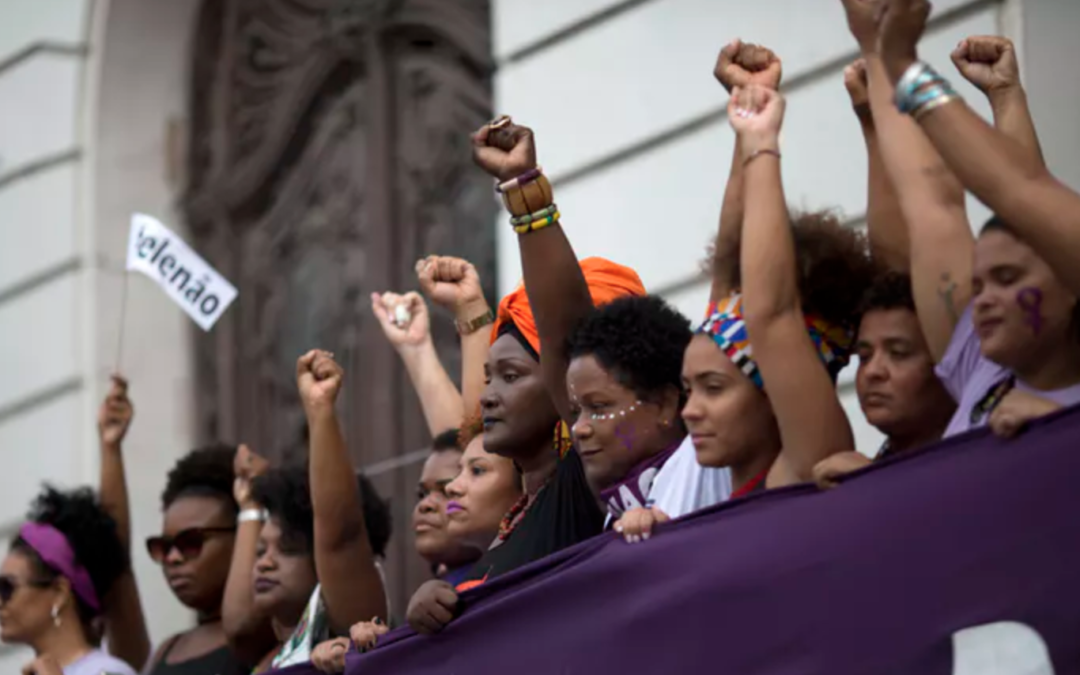
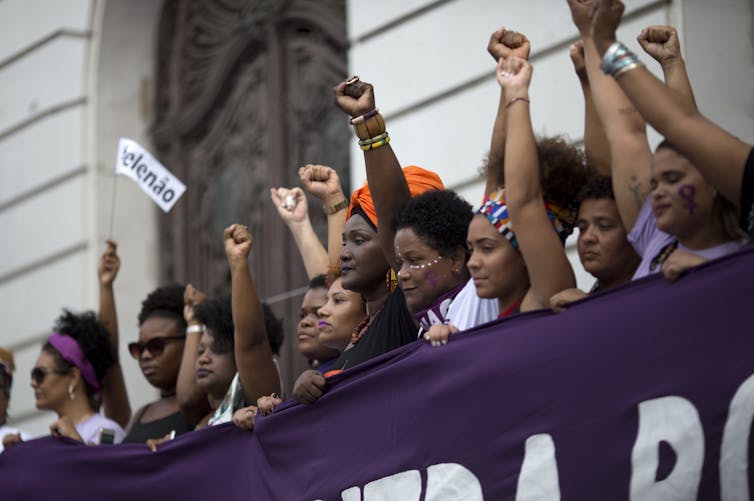
Black women in Brazil protest presidential frontrunner Jair Bolsonaro, who is known for his disparaging remarks about women, on Sept. 29, 2018. AP Photo/Silvia Izquierdo
Motivated in part by President Donald Trump’s disparaging remarks about women and the numerous claims that he committed sexual assault, American women are running for state and national office in historic numbers. At least 255 women are on the ballot as major party congressional candidates in the November general election.
The surge includes a record number of women of color, many of whom say their candidacies reflect a personal concern about America’s increasingly hostile, even violent, racial dynamics. In addition to the 59 black female congressional candidates, Georgia’s Stacey Abrams hopes to become her state’s first black governor.
The U.S. is not the only place where the advance of racism and misogyny in politics has has spurred black women to run for office at unprecedented levels.
In Brazil, a record 1,237 black women will be on the ballot this Sunday in the country’s Oct. 7 general election.
I’m a scholar of black feminism in the Americas, so I have been closely watching Brazil’s 2018 campaign season – which has been marked by controversy around race and gender – for parallels with the United States.
Last weekend, hundreds of thousands of Brazilian women marched nationwide against the far-right presidential frontrunner Jair Bolsonaro, under the banner of #EleNao – #NotHim.
Bolsonaro, a pro-gun, anti-abortion congressman with strong evangelical backing, once told a fellow congressional representative that she “didn’t deserve to be raped” because she was “terrible and ugly.”
Bolsonaro has seen a boost in the polls since he was stabbed at a campaign rally on Sept. 8 in a politically motivated attack.

Protests in Rio de Janeiro against Jair Bolsonaro on Sept. 29, organized under the hashtag #EleNao (#NotHim). AP Photo/Silvia Izquierdo
Brazil has shifted rightward since 2016, when the left-leaning female president Dilma Rousseff was ousted in a partisan impeachment process that many progressives regard as a political coup.
Her successor, then-Vice President Michel Temer, quickly passed an austerity budget that reversed many progressive policies enacted under Rousseff and her predecessor, Workers Party founder Luís Inácio “Lula” da Silva.
The move decimated funding for agencies and laws that protect women, people of color and the very poor.
In Brazil, these three categories – women, people of color and the very poor – tend to overlap.
Brazil, which has more people of African descent than most African nations, was the largest slaveholding society in the Americas. Over 4 million enslaved Africans were forcibly taken to the country between 1530 and 1888.
Brazil’s political, social and economic dynamics still reflect this history.
Though Brazil has long considered itself colorblind, black and indigenous Brazilians are poorer than their white compatriots. Black women also experience sexual violence at much higher rates than white women – a centuries-old abuse of power that dates back to slavery.
Afro-Brazilians – who make up just over half of Brazil’s 200 million people, according to the 2010 census – are also underrepresented in Brazilian politics, though sources disagree on exactly how few black Brazilians hold public office.
Three Afro-Brazilians serve in the Senate, including one woman. In the 513-member lower Chamber of Deputies, about 20 percent identify as black or brown. Women of color hold around 1 percent of seats in the Chamber of Deputies.
That could change on Sunday.
This year, 9,204 of the 27,208 people running for office across Brazil are women, which reflects a law requiring political parties to nominate at least 30 percent women. About 13 percent of female candidates in 2018 are Afro-Brazilian.

A campaign ad for Rio city council member Talíria Petrone, who is running for Congress. Facebook
In most Brazilian states, that’s a marked increase over Brazil’s last general election, in 2014, according to the online publication Congresso em Foco.
In São Paulo, Brazil’s most populous state, 105 black women ran for office in 2014. This year, 166 are. In Bahia state, there are 106 black female candidates for political office, versus 59 in 2014. The number has likewise doubled in Minas Gerais, from 51 in 2014 to 105 this year.
As in the United States, Brazil’s black wave may be a direct response to alarming social trends, including sharp rises in gang violence and police brutality, both of which disproportionately affect black communities.
But many female candidates in Rio de Janeiro, Brazil’s second largest city, say one specific event inspired them to run.
In March, Marielle Franco, an Afro-Brazilian human rights activist and Rio de Janeiro city councilwoman, was assassinated – the 11th Brazilian activist to be murdered since November 2017.
Franco’s murder remains unsolved, but she was an outspoken critic of the military occupation of Rio’s poor, mostly black favela neighborhoods. The ongoing police investigation has implicated government agents in the shooting, which also killed her driver.
Her death unleashed an avalanche of activism among black women in Rio de Janeiro, with new groups offering fundraising and political training for female candidates of color.
On Sunday, 231 black women from Rio de Janeiro state will stand for election in local, state and federal races – more than any other state in Brazil and more than double the number who ran in 2014.
Black women may have been historically excluded from Brazil’s formal political arena, but they have been a driving force for social and political change since the country’s transition from dictatorship to democracy in 1985.
Decades before #MeToo, Brazilian women of color were on the front lines of activism around issues like gender-based violence, sexual harassment and abortion.
Brazil has hundreds of black women’s groups. Some, including Geledes, a center for public policy, are mainstays of the Brazilian human rights movement. The founder of the Rio de Janeiro anti-racism group Criola, Jurema Werneck, is now the director of Amnesty International in Brazil.
The fact that thousands of black women, both veteran activists and political newcomers, will appear on the ballot on Sunday is testament to their efforts.
As in the United States, black Brazilian women’s demand for political representation is deeply personal. They have watched as their mostly male and conservative-dominated congresses chipped away at hard-won protections for women and people of color in recent years, exposing the fragility of previous decades’ progress on race and gender.
Black women in Brazil and the U.S. know that full democracy hinges on full participation. By entering into politics, they hope to foster more inclusive and equitable societies for all.![]()
Kia Lilly Caldwell, Professor, African, African American, and Diaspora Studies, University of North Carolina at Chapel Hill
This article is republished from The Conversation under a Creative Commons license.